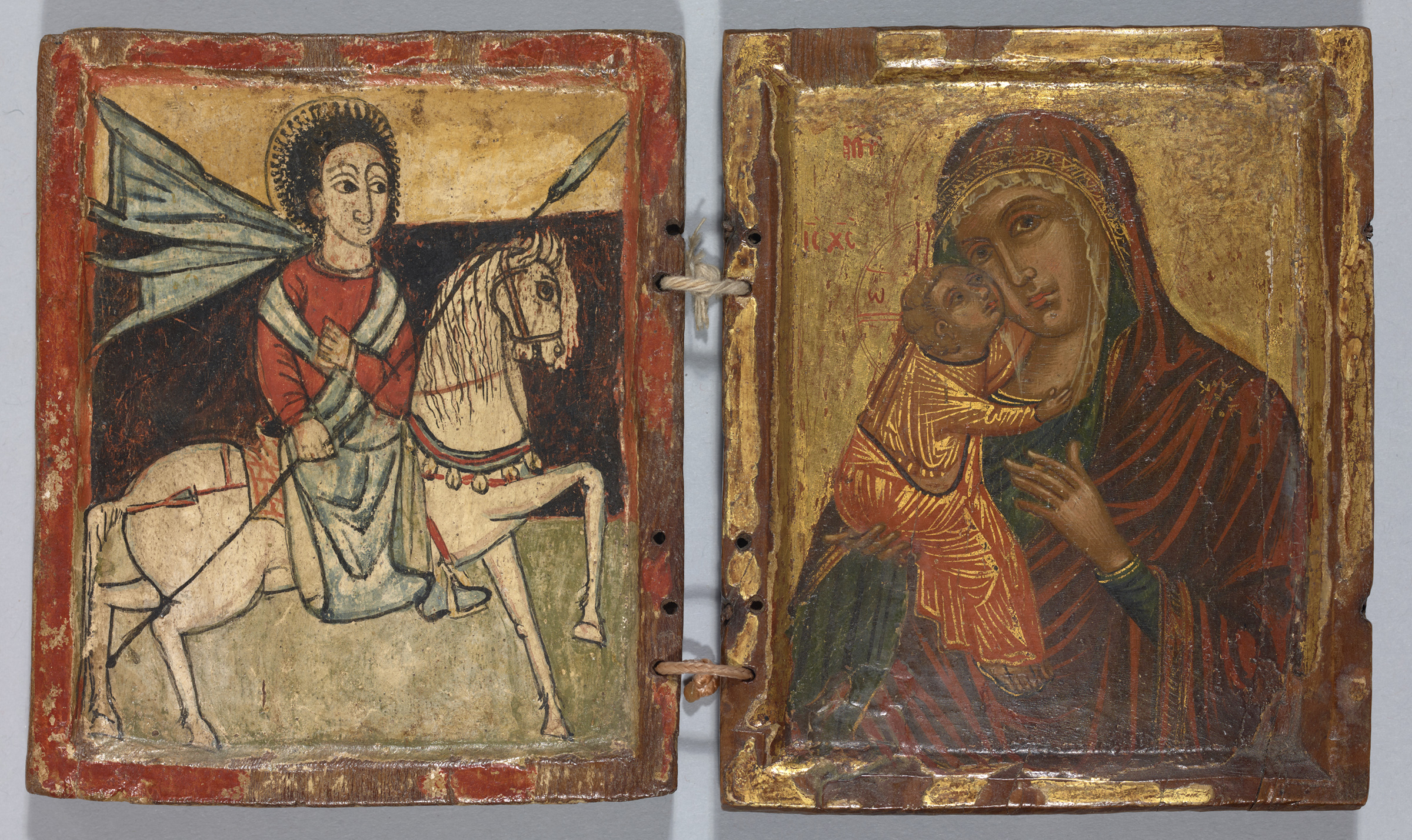Diptych with Saint George, and the Virgin and Child

Present-day Ethiopia (Virgin and Child wing likely produced in the Mediterranean, perhaps present-day Crete)
Wood, tempera
Height: 4.8 in (12.2 cm); width (open): 7.9 in (20 cm)
Wyvern Collection, 0472
The adoption of Christianity in the fourth century by the Aksumite Empire—an area corresponding with present-day Eritrea and northern Ethiopia—led to the development of a new tradition of Christian painting. In adopting the new religion, the Aksumite Empire solidified its relationship with the Roman Empire, and unified the culturally diverse peoples living in the region. During the Zagwe Dynasty (tenth or eleventh century–1270) and the early Solomonic period (1270– 1530) of the Ethiopian Empire, the growth and development of Christianity saw an increasing affiliation between monasteries, artists, and political leaders. Ethiopian pilgrims and diplomats traveled to the Mediterranean region, and European artists are known to have traveled to Ethiopia (see cat. 30), and these points of contact brought new media, aesthetic sensibilities, and styles of working to Ethiopia. (1) During this period, Christian iconography marked church interiors, devotional and liturgical objects, painted icons and illustrated manuscripts, with functions and impacts analogous to European art of the period. Ethiopian artists at this time, especially when creating works for ritual use, prioritized the powerful expression of spiritual truth. Visually, their work is characterized by exaggerated proportions, static poses, and flattened bodies of figures. (2)
This unusual diptych challenges expectations by demonstrating two styles within a single work: one associated with local Ethiopian painters working on wood, and one clearly drawing on foreign models, inspired perhaps by illuminated manuscripts or Byzantine Icon painting, and probably executed by a Mediterranean painter. The left wing of the diptych depicts Saint George with strong black outlines that emphasize and flatten the form. The saint’s body extends forward, initiated by the reach of his sword, yet still in a static position. By contrast, the right wing depicts the Virgin Mary in a more volumetric, rounded form. The Virgin and Child are framed with light, creating highlights and shadows that define the figures. The Virgin wears a heavy cloak, painted with lines and shadows that give the appearance of draping fabric. It is unclear when these two panels were first joined together, and differences in the character of the wood used in the two panels, as well as the differences in painting techniques, suggest that they were not made at the same moment. However, the dimensions and formats of the two panels are closely matched, making it likely that whichever was made later was intended to be joined to the earlier panel.
Saint George raises his sword towards the Virgin Mary, symbolizing his determination to protect the Virgin from any evil that might threaten her, consistent with traditional Ethiopian Christian iconography that celebrated Saint George’s role as a warrior. As the patron saint of Ethiopia, George is represented in many manuscripts, church murals, and panel paintings, alongside the Virgin Mary. (3)
Amanda Banasiak, Class of 2020
Notes
- Campbell 2004; Krebs 2016.
- Grierson 1993; Holbert et al. 2001.
- Chojnacki 1973.